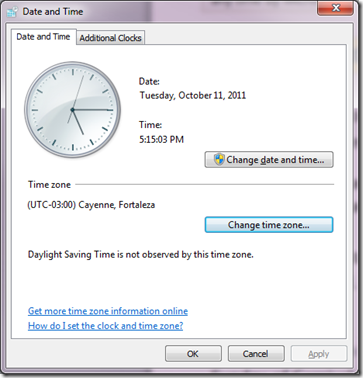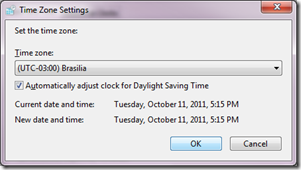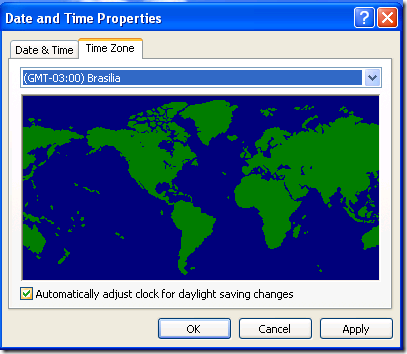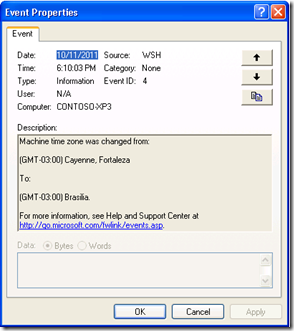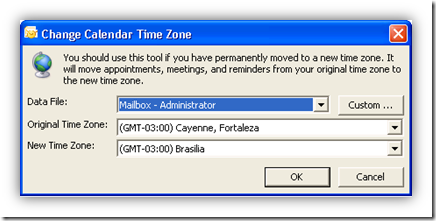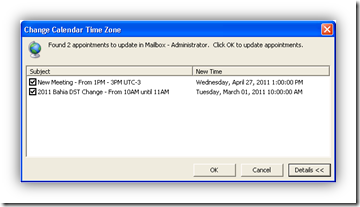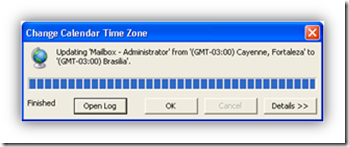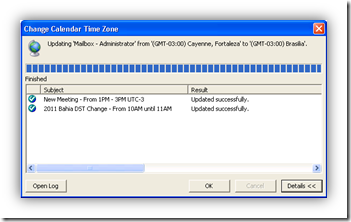Upcoming DST changes for Bahia, Brazil 2011
Disclaimer: The information in this document is written based on the recent announcement that the Brazilian State of Bahia will follow a DST schedule starting in 2011.
The steps provided in this bulletin were created to mitigate the impacts that the daylight saving time may cause for customers in Brazil. These are the impacts primarily anticipated at the time this document was written, and the effects that customers may face are not restricted to them.
The suggested actions on this document might receive additional testing. This document contains information about how to modify the registry. Make sure that you back up the registry before you modify it. Make sure that you know how to restore the registry if a problem occurs.
The information described in this document may change without notice. In addition, customers should be aware that further guidance will be provided at any time by Microsoft.
Special notes: The official decree changing the DST dates in Bahia that was published on 10/03/2011 is available at this location: https://www.comunicacao.ba.gov.br/noticias/2011/10/03/governador-jaques-wagner-anuncia-adesao-da-bahia-ao-horario-de-verao
Background – Bahia DST 2011 changes
The governor of Bahia has announced that the Brazilian state will adopt the same DST schedule as Brasilia.
For the 2011/2012 period the new DST schedule for Bahia will be the following:
· Daylight Saving Time starts at third Sunday of October (10/16/2011) at 12:00:00AM
· Daylight Saving Time ends at fourth Sunday of February (02/26/2012) at 12:00:00AM
Since the new date published by the government is different from what was defined in the previous years, Windows-based computers will not correctly interpret the time that is related to the transition to daylight saving time.
In addition to Microsoft products, other software, OS releases and hardware (phones, routers, switches and managed devices) may require updates and/or changes.
General recommendations
- Please note that if you adjust the machine’s clock manually, you may have adverse effects on your environment. This procedure is not supported by Microsoft.
- Before applying the changes on Windows Operating Systems to reflect the change in Daylight Saving Time in Bahia, be aware of potential issues that will affect Microsoft Office Outlook and Exchange Server. Read “Impacts for Outlook clients and Exchange” section for more details.
- Contact Microsoft Support prior to any modification if you are unsure about the steps to follow in order to be prepared for the Daylight Saving Time change in your location.
- The most recent cumulative update to daylight saving time (DST) and world time zones (TZ) is now available for supported versions of the Windows Operating System via Microsoft Download Center and Windows Update. For more information about this cumulative DST and TZ update, visit the following Microsoft Web site: https://support.microsoft.com/kb/2570791.
Impacts for Outlook clients and Exchange
The last time that Bahia adopted a DST schedule was 8 years ago. With the DST adoption there will be a period of time were appointments will have different time zone definitions. We are going to call this difference “Extended DST Period” or “Delta Period”.
For the year 2011, we have a delta period that corresponds to the whole DST period as follows:
Delta periods for Bahia DST in 2011/2012:
From Sunday, October 16th, 2011 to Sunday, February 26th, 2012.
The inconvenience experienced by Outlook client users happens for all appointments during the delta periods that were created before the administrators update the DST dates on the operating system.
Those appointments will be off 1 hour. This may happen for both recurring and single-instance appointments.
The appointments created after the DST dates have been updated on the operating system will have the correct time.
Why do we experience this behavior?
To answer this question, we need to understand how Outlook schedule meetings and appointments:
Three factors affect the scheduling of a meeting and appointment in Outlook:
- The computer's clock setting (time).
- The computer's local time zone setting.
- The computer's daylight saving time adjustment setting.
Outlook time stamps the message request with the Greenwich Mean Time for the meeting. Outlook calculates Greenwich Mean Time by using the computer's clock time, plus or minus the local time zone adjustment, minus (depending upon the time of year) the daylight-saving time adjustment.
As soon as Outlook receives the meeting request it will calculate the meeting time for the recipient and schedule it on the calendar. If any of the three factors listed earlier are incorrect at that time, the meeting time will be incorrect. You cannot correct the time after the fact by correcting the factor in error; you must open the meeting request and manually correct the scheduled time.
Options to update Windows Operating Systems and correct Outlook calendars
The new DST period for the Bahia shares the same schedule with several other states in Brazil. For customers that live in Bahia the option is to adopt the corresponding time zone to update the Operating Systems and Outlook calendar. The following table describes the appropriate choice:
State |
Current time zone: |
Change to: |
Bahia |
(UTC-03:00) Cayenne, Fortaleza |
(UTC-03:00) Brasilia |
Table 1: Time zones
This section describes the anticipated impacts of this change. We recommend customers to evaluate the alternative and test before apply on their environment.
Applies to:
· Windows XP, Windows 2003, Windows Vista, Windows 7, Windows Server 2008 and Windows Server 2008 R2 users
Note:
· Administrators will not be required to take any further actions when the DST ends in Bahia. Once configured on the proper time zone the machine will follow the new DST schedule.
· Administrators will not be able to correct calendar items in a centralized way (directly on the Exchange Server).
The following graph shows a summary of tasks associated with this change:
Below is a brief description of these activities:
Item |
When |
Activity |
1 |
As fast as possible, before October 16th, 2011 |
Change machine time zone to the proper time zone in Windows. This section is detailed in the “Changing Windows OS time zone” |
2 |
As soon as operating system is updated |
Adjust Outlook calendar appointments. This section is explained in ‘Adjusting Outlook calendars for users in Bahia who moved to a different time zone’’ |
Changing Windows OS time zone
In order to change the computer time zone to a different time zone, please follow the steps below:
For Windows Vista, Windows Server 2008, Windows 7 and Windows 2008 R2 machines:
1. Click Start and type:
control timedate.cpl
2. Click ‘Change time zone…’ button:
3. Select the time zone “(UTC-03:00) Brasilia” and click OK
Note: Make sure that the box ‘Automatically adjust clock for daylight saving changes’ is checked.
For Windows 2000, Windows XP and Windows Server 2003 machines:
1. Click Start button, select ‘Run’ and type the following command:
control timedate.cpl
2. From the dropdown list select the time zone “(UTC-03:00) Brasilia” and click OK:
Note: Make sure that the box ‘Automatically adjust clock for daylight saving changes’ is checked.
Automatically changing machine time zone to a new time zone on Active Directory environments
Warning: Users running Windows Vista and Windows Server 2008 must install hotfix KB2556308 before they can apply the following steps. This hotfix adds the TZUtil command-line tool to Windows Vista and Windows Server 2008 operating systems. You can use the TZUtil command-line tool to change or verify the current time zone on a computer that is running Windows Vista or Windows Server 2008.
On Active Directory environments, administrators may want to automate the change of time zones to a new time zone. This section explains how to deploy this time zone change via startup script. These procedures need to be executed in a Domain Controller or another machine with Admin Tools installed.
After performing all the steps below, all machines need to be restarted to automatically change the computer time zone. To avoid restarting a specific machine, please execute the procedures ‘Changing Windows OS time zone’ above to move this machine to a new time zone.
Use a script to change the machine time zone to a different time zone
The script below can be used to change the current time zone to “(UTC -03:00) Brasilia” on the client computer. Then, the script writes an event on the Application log of the client computer where the script was run.
1. Click Start, click Run, type notepad, and then press ENTER.
2. Copy the following code, and then paste it into the Notepad document. The following VBS Sample is only supported in Windows XP and Windows 2003.
On Error Resume Next strNewTimeZone = "E. South America Standard Time" Set objSh = CreateObject("WScript.Shell") 'Get the StandardName key of the current time zone szStandardName = objSh.RegRead("HKLM\SYSTEM\CurrentControlSet\Control\TimeZoneInformation\StandardName") 'Enumerate the subkeys in the time zone database Const HKEY_LOCAL_MACHINE = &H80000002 Set objReg = GetObject("winmgmts:{impersonationLevel=impersonate}!\\.\root\default:StdRegProv") szTzsKeyPath = "SOFTWARE\Microsoft\Windows NT\CurrentVersion\Time Zones" objReg.EnumKey HKEY_LOCAL_MACHINE, szTzsKeyPath, arrTzSubKeys 'Step through the time zones to find the matching Standard Name szCurrentTzKey = "<Unknown>" For Each subkey In arrTzSubKeys strTimeZoneStandarName = "" strTimeZoneStandarName = objSh.RegRead("HKLM\" & szTzsKeyPath & "\" & subkey & "\Std") If (strTimeZoneStandarName = szStandardName) Then 'Found matching StandardName, now store this time zone key name szCurrentTzKey = subkey End If Next Dim process, processid, result, strUpdateCommand Set process = GetObject("winmgmts:{impersonationLevel=impersonate}!\\.\root\cimv2:Win32_process") 'Add time change privilege to the process object process.Security_.Privileges.AddAsString "SeSystemTimePrivilege", True strUpdateCommand = "control.exe timedate.cpl,,/Z" & strNewTimeZone 'Launch control.exe to change time zone using the TZ key name stored in strNewTimeZone result = process.Create(strUpdateCommand, Null, Null, processid) If result <> 0 Then objSh.LogEvent 1, "Process to change machine time zone failed to execute on this computer. Unable to change machine time zone." wScript.Quit 0 End If 'Get the display name from previous time zone and compare with the new time zone szPrevDispName = objSh.RegRead("HKLM\" & szTzsKeyPath & "\" & szCurrentTzKey & "\Display") szNewDispName = objSh.RegRead("HKLM\" & szTzsKeyPath & "\" & strNewTimeZone & "\Display") 'Write entry to the Application event log stating that the update has executed If szPrevDispName = szNewDispName Then objSh.LogEvent 4, "Machine time zone was refreshed. The current time zone is: " & Chr(13) & Chr(10) & Chr(13) & Chr(10) & szNewDispName & "." Else objSh.LogEvent 4, "Machine time zone was changed from: " & Chr(13) & Chr(10) & Chr(13) & Chr(10) & szPrevDispName & Chr(13) & Chr(10) & Chr(13) & Chr(10) & "To: " & Chr(13) & Chr(10) & Chr(13) & Chr(10) & szNewDispName & "." End If |
3. On the File menu, click Save As.
4. Select a destination, and then type “2011_Bahia_ChangeTZ.vbs” in the File name box.
5. In the Save as type box, click All Files, and then click Save.
6. Double click in the 2011_Bahia_ChangeTZ.vbs to refresh time zone information.
Note: Microsoft provides programming examples for illustration only, without warranty either expressed or implied. This includes, but is not limited to, the implied warranties of merchantability or fitness for a particular purpose. This article assumes that you are familiar with the programming language that is being demonstrated and with the tools that are used to create and to debug procedures. Microsoft support engineers can help explain the functionality of a particular procedure. However, they will not modify these examples to provide added functionality or construct procedures to meet your specific requirements.
Deploying time zone changes using Group Policy
1. Click Start, click Run, type notepad, and then press ENTER.
2. Copy the following lines, and then paste it into the Notepad document.
a. The script will test the Operating System version and apply the VBS described above on Windows XP and Windows 2003. For Windows 7 and Windows 2008 R2 the script uses the utility TZUTIL to change the time zone. The scrip will enable the DST check box if the machine is already in “(UTC-03:00) Brasilia” but the DST checkbox is disabled.
b. Windows Vista and Windows 2008 machines will need to apply KB2556308 before follow this instructions. The KB2556308 introduces the tool TZUTIL to Windows Vista and Windows 2008.
@echo off ver |find /i "6.">nul IF %errorlevel% EQU 0 GOTO SIX cscript \\contoso.com\NETLOGON\2011_Bahia_ChangeTZ2011.vbs GOTO End :SIX TZUTIL /G |Find /i "E. South America Standard Time_dstoff" >nul IF %errorlevel% EQU 0 GOTO Brasilia TZUTIL /G |Find /i "SA Eastern Standard Time" >nul IF %errorlevel% EQU 0 GOTO Brasilia GOTO End :Brasilia TZUTIL /s "E. South America Standard Time" GOTO End :End |
Note: You must replace the \\contoso.com notation above with the actual DNS domain name for your Active Directory domain.
3. On the File menu, click Save As.
4. Select a destination, and then type 2011_Bahia_ChangeTZ.cmd in the File name box.
5. In the Save as type box, click All Files, and then click Save.
6. Copy the following files to the Netlogon share folder of the domain controller that holds the PDC emulator role in the domain:
2011_Bahia_ChangeTZ.cmd
2011_Bahia_ChangeTZ.vbs
7. Wait until Active Directory replication occurs. Also, wait until the files and folders in the system volume (SYSVOL) shared folder replicate to domain controllers in the domain.
8. Click Start, click Run, type control admintools, and then click OK.
9. Double-click Active Directory Sites and Services.
10. Select a site where the computers in Bahia are located. (Small environments may have only a site named ‘Default-First-Site-Name’).
11. Right-click this site, and then click ‘Properties’.
12. Click the Group Policy tab, click New, type DST Time Zone Change, and then press ENTER.
13. Click Edit. The Group Policy Object Editor tool starts.
14. Expand Computer Configuration, expand Windows Settings, and then click Scripts (Startup/Shutdown).
15. Double-click Startup, and then click Add.
16. In the Script Name box, type the universal naming convention (UNC) path of the ChangeTZ.cmd file that is located in the Netlogon share. For example, type:
\\contoso.com\NETLOGON\2011_Bahia_ChangeTZ.cmd
17. Click OK two times.
The following event is registered on the Application Log of every Windows XP and Windows 2003 machine where it was executed:
Adjusting Outlook calendars for users in Bahia who moved to a different time zone.
As soon as you move to a new time zone, all Outlook calendar items during the DELTA Periods (Sunday, October 16th, 2011 to Sunday, February 26th, 2012) will be displayed with 1 hour off.
Options to correct your Outlook calendar in this scenario:
- Manually modify each appointment on the affected period (Sunday, October 16th, 2011 to Sunday, February 26th, 2012) after the operating system time zone has been changed. Instructions on the section “How to manually modify Outlook Calendar items”
- or -
- Customers may also opt to use the "Outlook Time Zone Data Update Tool version 3.0" on the mode Permanent Time Zone Move to correct the Outlook calendar items. This procedure is explained below.
Special note: We recommend you to print your calendar before any changes are made, and then review the calendar items to make sure these items appear at the correct times. You can use this printed copy of the calendar items to verify that Outlook has been updated successfully.
Step by step procedure to use “Outlook Time Zone Data Update Tool version 3.0” after a time zone move
The following describes the steps to be followed by end-users performing a time zone move:
The steps below can be followed for users who changed their time zone configuration to “(UTC -03:00) Brasilia”.
Download and run the installation package from:
32-bit version: https://www.microsoft.com/download/en/details.aspx?id=17291
64-bit version: https://www.microsoft.com/download/en/details.aspx?id=16271Go to Start, All Programs, Microsoft Office Outlook Tools, Time Zone Data Update Tool and Select "Permanent Time Zone Move Mode".
Properly select “(UTC -03:00) Cayenne, Fortaleza” from the “Original Time Zone:” drop down, and “(UTC -03:00) Brasilia” for the “New Time Zone:” drop down and click OK.
NOTE: As with standard time zone updates, the tool defaults to updating affected items on your Calendar and in your Reminders folder. If you would like to update additional items (e.g. items in additional Calendars or a PST), you can do so by clicking the ‘Custom…’ button and manually selecting the target folder.
5. The tool will inspect your mailbox and will report how many appointments will be moved:
If you click “Details” the appointment list will appear and you will be able to select all (default) or some of the appointments. In a normal situation you will move all the appointments to the new time zone. Click “OK” in the following dialog to proceed moving the appointments. A log file “Outlook Time Zone Update .log” will be generated in the %temp% directory.
6. Click "OK" to correct the calendar items listed. If you click “Details” the appointment list will appear and you will be able to see if all the appointments were updated.
7. After the update click “OK” again to close the tool.
8. Review your calendar items from Sunday, October 16th, 2011 to Sunday, February 26th, 2012 and verify they were correctly updated.
How to manually modify Outlook Calendar items:
After you move from another time zone to '(UTC -03:00) Brasilia", your calendar items will be one hour off on the Delta Period, from Sunday, October 16th, 2011 to Sunday, February 26th, 2012.
A simpler alternative to correct the Outlook Calendar items is by adjusting the appointments manually. To do so, please proceed as follows:
1. Start Outlook, and then open the Outlook calendar.
2. Manually move each meeting that you organized so that they occur at the correct time.
3. Send an update for each meeting that you moved to the meeting attendees. This action causes the calendar for each attendee to display the correct time for the meeting.
4. Manually move each single-instance appointment.
5. Manually move all recurring appointments that occur in the extended DST period.
Recommendations to minimize the impacts on Outlook/Exchange:
- Simulate the changes on a lab environment, so you know what will happen and what to expect.
- Work in conjunction with the operating system team to update the DST dates as soon as possible to minimize the chance of users creating new appointments during the delta period before the operating system DST dates get updated.
- Before doing any change on the DST information, request the users to print their schedule so they have a reference to follow in order to manually update the appointments later if needed.
- Take a full online backup of your Exchange Servers in case you decide to use the Exchange Calendar Update Tool.
- For the meetings with multiple attendees only the meeting requestor should update the time and send the update to the others.
- Include the time of the meeting in the e-mail request so that invitees can double check the correct meeting time (such as, "Project brainstorming - 11:00 A.M. Brasilia Time").
- Exercise caution with the appointments and meetings in the extended DST period. When in doubt, verify the correct time with the organizer.
References:
941018 How to address daylight saving time by using the Exchange Calendar Update Tool
934001 A troubleshooting guide to the Exchange Calendar Update Tool (Msextmz.exe)
931667 How to address time zone changes by using the Time Zone Data Update Tool for Microsoft Office Outlook
943390 Some Outlook calendar items are rebased incorrectly when you use the Outlook Time Zone Data Update Tool to adjust for daylight saving time changes in certain time zones



